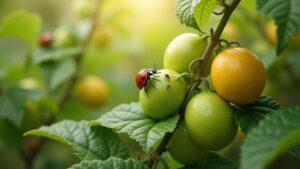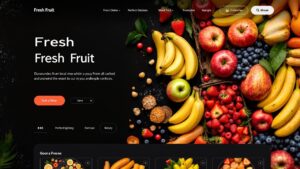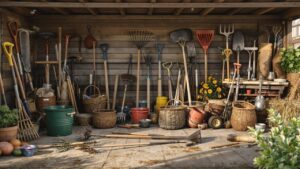Imagine stepping into your backyard and plucking a perfectly ripe peach from your own tree or popping handfuls of sun-kissed blueberries straight into your mouth. Sounds dreamy, right? The good news: this isn’t some far-off homestead fantasy—it can be your reality with a few pro-level gardening tweaks. Whether you’re a weekend gardener or a full-on fruit fanatic, these expert tips will help you squeeze every last juicy ounce out of your garden.
Table of Contents
How to Maximize Your Fruit Yield

Get ready to boost your fruit yield like never before, with smart tools, high-yield varieties, and gardening strategies straight from the pros. Let’s dig in (literally).
1. Preparing the Perfect Foundation: Soil Quality is Everything 🌱
If you want a high yield, it all starts with the dirt under your feet. Healthy soil = happy plants. Think of your soil as the pantry for your fruit trees and shrubs—stock it well, and they’ll thrive. Neglect it, and you’re basically sending them to live off gas station snacks.
FAQ: How can I improve soil quality for better fruit production?
- Compost like a pro: Add organic compost regularly to enrich the soil with nutrients. Mushroom compost and worm castings are gold for garden soil.
- Test your soil: A quick pH test can save you from a world of trouble. Most fruit trees prefer a slightly acidic pH between 6.0 and 6.5. Adjust accordingly.
- Amendments are your best friends: Try these top amendments for boosting your soil:
| Soil Amendment | Benefit | Best For |
|---|---|---|
| Mushroom Compost | Adds nutrients and improves texture | All fruit trees and shrubs |
| Manure (aged) | Boosts nitrogen for leafy growth | Citrus and berry bushes |
| Peat Moss | Improves moisture retention | Blueberries and cranberries |
2. Picking the Right Players: High-Yield Fruit Tree Varieties for Small Spaces 🌳
Got limited space? No problem. With the right varieties, even a small backyard (or patio) can yield a bounty of fruit.
FAQ: Which fruit tree varieties are most suitable for high yields in small spaces?
- Dwarf and semi-dwarf trees are your secret weapon. They’re compact but still incredibly productive.
- Meyer Lemon: Perfect for pots, produces year-round in warmer climates.
- Kieffer Pear: A high-yielding heritage variety that’s tough and disease-resistant.
- Compact Apple Trees: Look for varieties like ‘Spartan’ or ‘Honeycrisp.’
Pro Tip: Espalier your fruit trees—train them to grow flat against a wall or fence to save space and increase sun exposure. Bonus: It looks super chic.
3. Succession Planting and Vertical Gardening: Growing Up (Literally) 🌿
Why settle for one harvest when you can have several? Succession planting keeps your garden producing all season long.
FAQ: What is succession planting, and how does it help increase fruit yield?
Succession planting is all about timing. Instead of planting everything at once, you stagger plantings for continuous harvests. For example, plant strawberries in early spring, then switch to raspberries in midsummer.
FAQ: How can I use vertical gardening techniques to grow more fruit?
- Trellises and arbors: Great for climbing fruits like blackberries and grapes.
- Stacked planters: Perfect for strawberries and small fruits.
- Hanging baskets: Ideal for cherry tomatoes and dwarf citrus.
4. Smart Gardening Tools for Smarter Yields 🛠️
Forget guesswork—let technology help you garden like a boss.
FAQ: How do smart gardening tools, like sensors and irrigation systems, improve yield?
Smart tools take the stress out of gardening by monitoring conditions and automating care. Here are some must-haves:
- Smart Irrigation Controller: Waters your garden on a schedule and adjusts for weather.
- Automated Garden Monitoring App: Tracks plant health and sends alerts if something’s off.
- Soil Moisture Sensors: Prevents over- or under-watering by monitoring moisture levels.
5. The Power of Pollination and Pest Management 🐝
No bees? No fruit. It’s that simple. Pollination is key to maximizing fruit production, so roll out the red carpet for your buzzing friends.
FAQ: What role does pollination play in maximizing fruit production?
Bees, butterflies, and even birds help transfer pollen between flowers, which leads to fruit. Plant pollinator-friendly flowers like bee balm and lavender to attract them.
FAQ: How can I protect my fruit trees from pests and diseases to ensure a good harvest?
- Use companion planting: Marigolds deter aphids, while nasturtiums repel squash bugs.
- Apply Organic Pest Control Spray for common issues like mites and caterpillars.
- Choose disease-resistant varieties to save yourself a lot of headaches.
6. Climate-Smart Gardening and Seasonal Planning 🌦️
Understanding your local climate is crucial for getting the most out of your garden.
FAQ: What is the impact of climate and seasonal planning on fruit yield?
Planting at the right time (and with the right varieties) makes all the difference.
- Drought-prone areas: Stick with drought-resistant varieties like figs and pomegranates.
- Cold climates: Opt for hardy fruit trees like apples and plums.
- Seasonal planting schedule: Map out your planting calendar to ensure continuous harvests.
Product Recommendations for Maximizing Your Fruit Yield
| Product Name | Description | Link |
|---|---|---|
| Espoma Organic Mushroom Compost | Premium compost to enrich soil and boost plant health | Espoma |
| Smart Irrigation Controller | Automated watering system to optimize water usage | Smart Controller |
| Vertical Garden Trellis | Space-saving trellis for climbing plants | Trellis |
| Bee Balm Seeds | Pollinator-attracting flowers to enhance pollination | Bee Balm |
| Heirloom Fruit Tree Varieties | Rare, high-yielding heritage fruits like Kieffer pears | Heritage Trees |
Conclusion: Grow More, Stress Less
Maximizing your fruit yield doesn’t have to be complicated. Start with healthy soil, choose high-yield varieties, and embrace smart tools and climate-friendly planning. Follow these tips, and you’ll be handing out baskets of homegrown fruit to friends and family before you know it.
Now it’s your turn: What’s your biggest gardening challenge? Drop a comment below and let’s keep the conversation growing!



